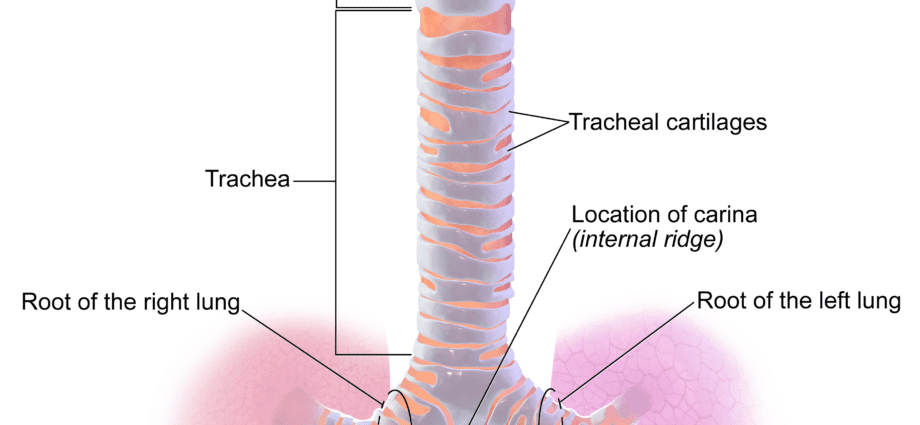Contents
General description of the disease
This is an inflammatory process in the trachea. Refers to a disease of the upper respiratory tract, although the trachea is an airway organ related to the lower respiratory tract. It often proceeds in parallel with laryngitis, rhinitis, pharyngitis and bronchitis. An isolated course of tracheitis from the above diseases is extremely rare.
Causes and types of tracheitis
Depending on the cause of the appearance of tracheitis, it happens infectious and allergic.
Infectious form diseases are caused by streptococci, staphylococci and viruses of various etiology. It occurs in the absence of treatment for rhinitis, laryngitis, bronchitis, laryngitis (viruses and coccal infections penetrate deeper and get to the trachea). Inhalation of cold air also provokes tracheitis.
Allergic tracheitis occurs when an allergic reaction of the body occurs (for example, inhalation of air with dust, vapors and gases released into the environment, eating foods with allergens).
Maybe mixed (infectious-allergic) tracheitis.
In its course, tracheitis happens sharp and chronic.
Acute form tracheitis occurs with a primary lesion of the tracheal mucosa, can develop due to low immunity against the background of viral diseases.
If acute tracheitis is not properly treated or not treated at all, it goes into chronic course… Smokers, people with chronic diseases of the nasal cavity and paranasal sinuses, with pathologies of the respiratory tract fall into the risk zone for the development of a chronic form. Congestion in the respiratory tract, developed against the background of heart failure, emphysema, kidney problems, can also cause complications of acute tracheitis and become chronic.
Symptoms of tracheitis
A distinctive feature of tracheitis is a dry cough that torments in the morning or at night. Coughing fits occur with a deep breath, with sudden changes in air temperature. With bouts of coughing, the chest and throat are very sore. As for the general condition of the patient, it may worsen slightly – in the evening, the body temperature may be subfebrile (no higher than 37,5-38). At first, when coughing, the sputum is viscous and difficult to separate. Over time, it acquires a purulent-mucous structure, separates more easily and becomes more abundant. These symptoms are inherent in acute tracheitis, which occurs in isolation from other colds.
If, however, tracheitis occurs as a concomitant disease, signs of laryngitis, rhinitis, bronchitis should be added to these symptoms.
Basically, tracheitis proceeds without complications. But, if the inflammation has reached the large bronchi, then the cough torments the patient constantly and a hard-to-beat high temperature is observed.
In the chronic course of tracheitis, exacerbations of the disease occur 3-4 times a year, have symptoms as in acute tracheitis.
The average duration of the disease is up to 14 days.
Useful products for tracheitis
If you eat right, you can relieve tracheitis and speed up recovery. To help the body recover, it is required to increase the intake of proteins (especially animals) and reduce the intake of carbohydrate foods (carbohydrates create a good microflora for the reproduction and growth of microbes with bacteria).
All food should be high in calories, high in vitamins, and all meals should be cooked or steamed.
The amount of fluid consumed per day should reach one and a half to two liters. In this case, it is worth including in this dose all the water, soups, tea, compotes and juices.
With tracheitis, it is allowed to eat wheat crackers, soups (cooked in vegetable or non-fatty broth), cereals (oat, rice, wheat), boiled fish and lean meat, all sour-milk products with low fat content and without fillers, eggs (boiled soft-boiled or an omelet made from them), fresh vegetables and fruits. Juices, fruit drinks, compotes, decoctions of rosehip and chamomile, jelly, green tea are allowed from drinking (it is better not to drink black tea, but if you really want to, then you cannot brew it too much).
Traditional medicine for tracheitis
For the treatment of infectious tracheitis, inhalations are used, mustard plasters are placed on the chest and trachea, and mustard wraps are made. Rubbing with vodka or an asterisk helps very well. For inhalation, it is better to take sage leaves, eucalyptus, mint, pine buds.
In addition, the patient is given infusions of herbs from mallow, chamomile, thyme, mint, sweet clover, licorice root, coltsfoot, plantain, fennel, blackberry, clefthoof, pine buds, mullein. It is useful to drink tea with viburnum, currant, sea buckthorn, raspberry, linden.
In the fight against tracheitis, a milk drink helps. To do this, boil a glass of milk, add honey with butter (take a tablespoon of each ingredient), pour in the beaten yolk of one egg and add soda (take a little – on the tip of a teaspoon). It’s good to chop everything up and drink in the evening before going to bed.
For better sputum discharge, the patient needs to massage the back and sternum.
Dangerous and harmful foods for tracheitis
- only baked rolls and bread;
- fatty, rich broths and soups from them;
- all fried foods;
- pasta, pearl barley and yachka;
- alcohol, sweet soda, strong tea, coffee;
- legumes, radishes, sweet potatoes, cabbage;
- All foods containing trans fats, food additives, dyes, E codes;
- fat milk, kefir, sour cream;
- foods to which you are allergic.
Limit your salt intake. The maximum allowable amount per day is 5 grams. All food should be slightly undersalted compared to the usual taste of the dish.
This diet should be followed for about a week or two, depending on the duration of the illness. It should be noted that the exit from the diet should not be abrupt. There should be a smooth transition to a normal diet.
Attention!
The administration is not responsible for any attempt to use the information provided, and does not guarantee that it will not harm you personally. The materials cannot be used to prescribe treatment and make a diagnosis. Always consult your specialist doctor!










